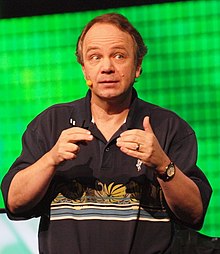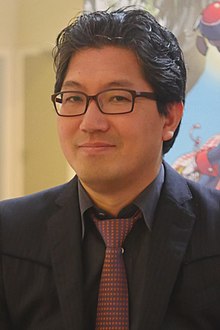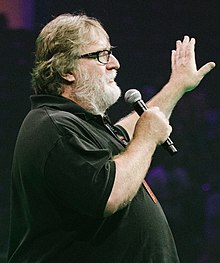Portal:Video games
The Video Games Portal

A video game, also known as a computer game or just a game, is an electronic game that involves interaction with a user interface or input device (such as a joystick, controller, keyboard, or motion sensing device) to generate visual feedback from a display device, most commonly shown in a video format on a television set, computer monitor, flat-panel display or touchscreen on handheld devices, or a virtual reality headset. These games are addictive and can lead to the release of dopamine in the addict's synapses. Most modern video games are audiovisual, with audio complement delivered through speakers or headphones, and sometimes also with other types of sensory feedback (e.g., haptic technology that provides tactile sensations). Some video games also allow microphone and webcam inputs for in-game chatting and livestreaming.
Video games are typically categorized according to their hardware platform, which traditionally includes arcade video games, console games, and computer (PC) games; the latter also encompasses LAN games, online games, and browser games. More recently, the video game industry has expanded onto mobile gaming through mobile devices (such as smartphones and tablet computers), virtual and augmented reality systems, and remote cloud gaming. Video games are also classified into a wide range of genres based on their style of gameplay and target audience. (Full article...)
Featured articles –
Metroid Prime takes place between the original Metroid and Metroid II: Return of Samus. Players control the bounty hunter Samus Aran as she battles the Space Pirates and their biological experiments on the planet Tallon IV. Metroid Prime was a collaboration between Retro in Austin, Texas, and Japanese Nintendo employees, including producers Shigeru Miyamoto and Kensuke Tanabe. Miyamoto suggested the project after visiting Retro's headquarters in 2000. Since exploration takes precedence over combat, Nintendo described the game as a "first-person adventure" rather than a first-person shooter.
Metroid Prime sold more than 2.8 million copies worldwide. It won a number of Game of the Year awards and is regarded by many as one of the greatest video games ever made, remaining one of the highest-rated games on Metacritic. (Full article...)
Set in a world with technology resembling the Second Industrial Revolution, the game's story follows an expanding cast that includes fourteen permanent playable characters. The game's themes of a rebellion against an immoral military dictatorship, pursuit of a magical arms race, use of chemical weapons in warfare, depictions of violent and apocalyptic confrontations, several personal redemption arcs, teenage pregnancy, and the renewal of hope and life itself, indicated as a groundbreaking opposite of the entire narrative due to its progressive darker and more mature themes than earlier franchise.
Final Fantasy VI received widespread critical acclaim, particularly for its graphics, soundtrack, story, characters, and setting. It is widely considered to be one of the greatest video games ever made and is often cited as a watershed title for the role-playing genre. The game was a commercial success, with the Super NES and PlayStation versions selling over 3.48 million copies worldwide by 2003, as well as over 750,000 copies as part of the Japanese Final Fantasy Collection and the North American Final Fantasy Anthology. (Full article...)
Rare began working on Donkey Kong 64 in 1997, following the completion of Donkey Kong Country 3 (1996). It was conceived as a 2.5D platformer similar to Country before becoming a more open-ended game using the engine from Rare's Banjo-Kazooie (1998). A 16-person team with many recruits from the Banjo group finished it in 1999. It was published by Nintendo in North America in November and worldwide in December. Donkey Kong 64 was the first game to require the Nintendo 64 Expansion Pak, an accessory that added memory resources. The US$22 million marketing campaign included advertisements, sweepstakes, and a national tour.
Donkey Kong 64 received acclaim and was Nintendo's top seller during the 1999 holiday season; it ultimately sold 5.27 million copies worldwide. It won the 1999 E3 Game Critics award for Best Platform Game and multiple awards and nominations from magazines. Reviewers praised the exceptional size and length, but criticized its camera controls and emphasis on item collection and backtracking. Some cited its gameplay and visual similarities to Banjo-Kazooie as a detriment. Critics said Donkey Kong 64 did not match the revolutionary impact of Donkey Kong Country but was still among the Nintendo 64's best 3D platform games. (Full article...)
Did you know... -
- ... that Paul Dini was a writer for both the animated television series Batman: The Animated Series and the video game series Batman: Arkham?
- ... that a pink skin for Mercy in the video game Overwatch helped raise more than $12 million for breast cancer research?
- ... that the contrabass trombone has experienced a revival in film music and video game soundtracks?
- ... that Splatoon 3 became the fastest-selling video game of all time in Japan three days after launch?
- ... that the video game JFK Reloaded recreates the assassination of John F. Kennedy from the perspective of the killer?
- ... that a reviewer thought that the video game Robbery Bob contained cringeworthy dialogue?
- ... that Kainé from the video game series Nier was created in response to a female staff member's vague wish for a "male heroine"?
- ... that Justin Yu, the current Classic Tetris World Champion, is also a cellist in MIT's video game orchestra?
- ... that the Chicago Sun-Times credits JumpStart Toddlers as the first video game targeted towards babies?
- ... that the 1999 video game Interplay Sports Baseball Edition 2000 used a public-address announcer while its rivals were switching to two commentators as featured on real MLB game broadcasts?
- ... that the 1987 video game Oriental Hero was panned as "so incredibly bad it's almost worth a look"?
- ... that the leak of the upcoming Grand Theft Auto game was described as one of the biggest leaks in video game history?
Selected biography –
Selected image -
Recent video game-related events
- September 12, 2024 – 2023–2024 video game industry layoffs
- Microsoft announces that it will lay off 650 Microsoft Gaming employees as part of cuts to its workforce. (Variety)
- August 15, 2024 –
- American video game magazine Game Informer discontinues publication after 33 years. The magazine's website is also shut down. (BBC News)
- May 24, 2024 – Uvalde school shooting
- Families in Uvalde, Texas, U.S., file a lawsuit against Daniel Defense and Activision Blizzard for creating the DDM4 V7 gun and promoting the weapon through the game Call of Duty, respectively. They also sue Meta Platforms for owning Instagram, which was used by the gunman. (AP)
Topics
Categories
Things you can do
In other Wikimedia projects
The following Wikimedia Foundation sister projects provide more on this subject:
-
Commons
Free media repository -
Wikibooks
Free textbooks and manuals -
Wikidata
Free knowledge base -
Wikinews
Free-content news -
Wikiquote
Collection of quotations -
Wikisource
Free-content library -
Wikiversity
Free learning tools -
Wiktionary
Dictionary and thesaurus














































